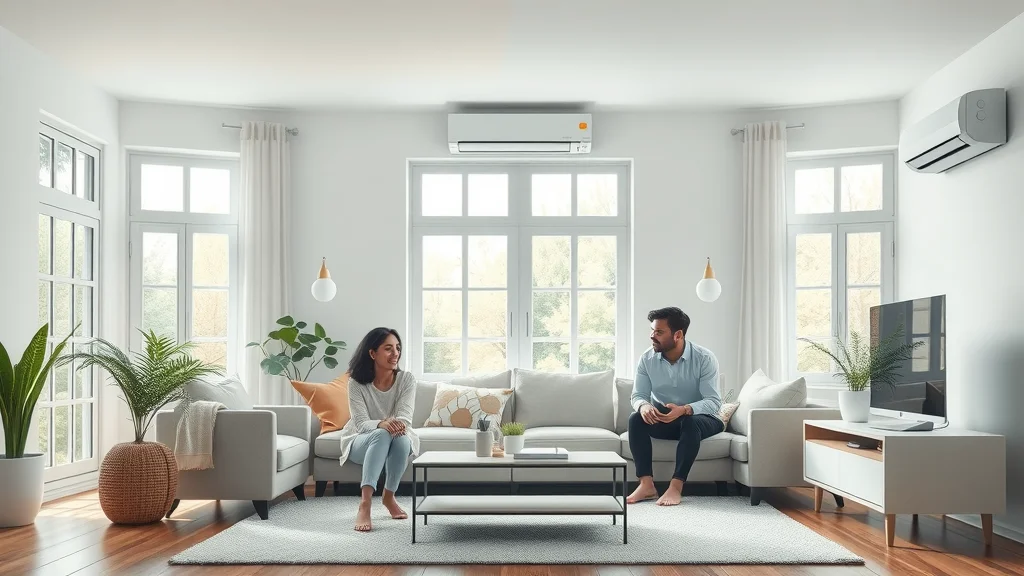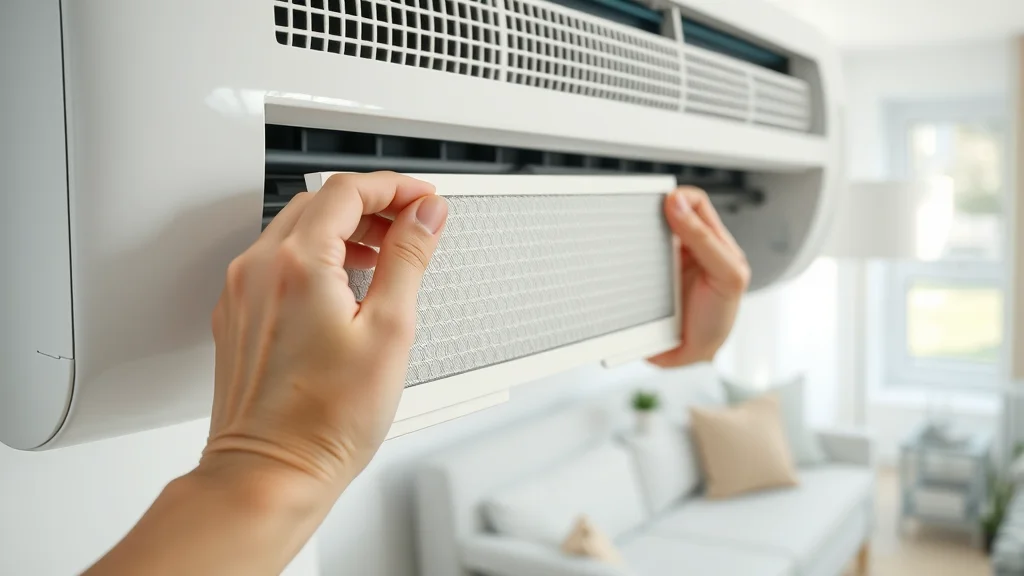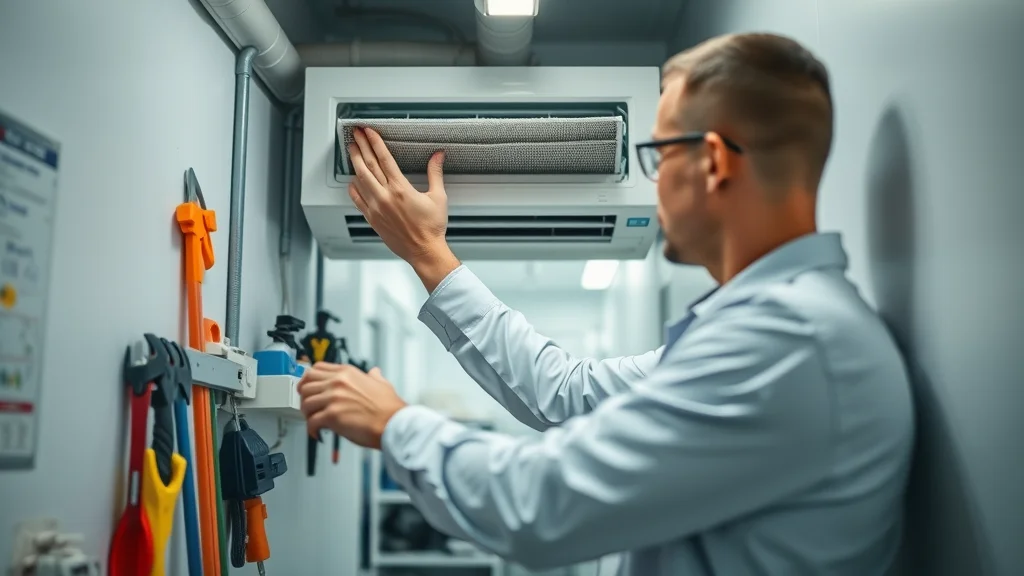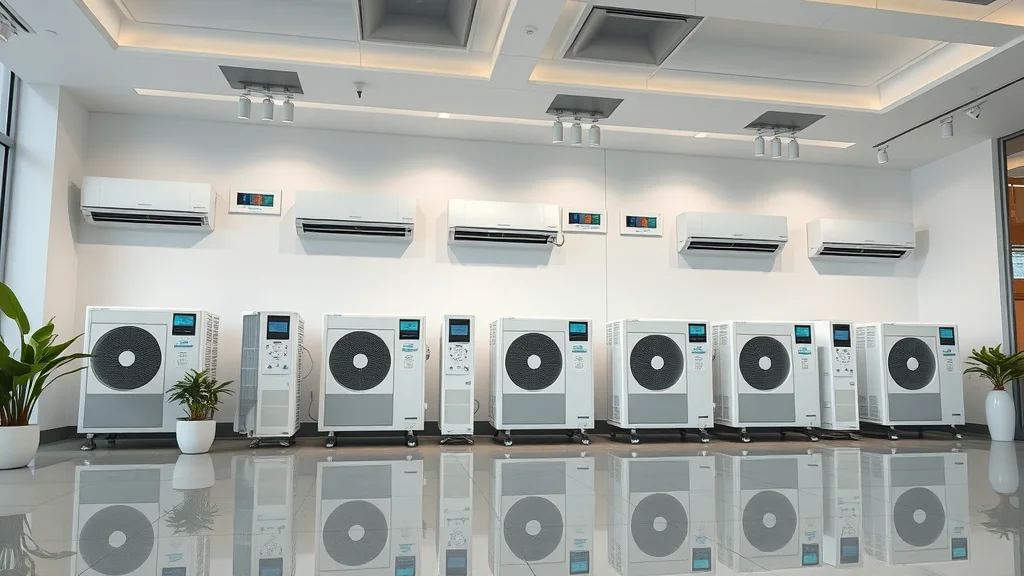Did you know that over 25 million Americans suffer from asthma—and that poor indoor air quality, often worsened by outdated or inefficient air conditioning systems, can aggravate their symptoms and trigger dangerous asthma attacks? The right air conditioning system doesn’t just keep your home cool; it could be the difference between constant discomfort and truly healthy breathing. This opinion piece dives deep into how energy-efficient asthma reduction AC units not only cut costs but also revolutionize the way asthma sufferers breathe at home—without sacrificing comfort or breaking the bank.
Revealing the Hidden Cost of Breathing: Air Conditioning & Asthma Statistics
Did you know more than 25 million Americans suffer from asthma, and poor indoor air quality—often exacerbated by inefficient AC systems—can make symptoms worse?
The statistics are sobering. According to the CDC, nearly 1 in 13 Americans struggles with asthma, with children bearing a significant burden. But what’s less discussed is how everyday choices, like your air conditioning system, directly influence the air you breathe and the frequency of asthma attacks. Inefficient or poorly maintained AC units often circulate dust, mold, pet dander, and even outdoor air pollution throughout your living space, silently raising asthma risks while driving up energy costs and utility bills. For asthma sufferers, these hidden costs are measured not just in dollars, but in quality of life and even hospital visits.
| Feature | Energy-Efficient Asthma Reduction AC | Traditional Air Conditioning System |
|---|---|---|
| Indoor Air Quality | Superior (HEPA filtration, humidity control) | Variable (often standard or outdated filtration) |
| Energy Efficiency | High (Eco-friendly, reduces energy costs) | Low-moderate (Higher utility bills, outdated tech) |
| Asthma Sufferer Benefits | Reduces asthma attacks, less dust & allergens | May aggravate symptoms and respiratory issues |
| Typical Costs (Over 10 years) | $3,000–$7,000 (lower long-term costs) | $5,000–$9,000 (due to higher energy use & repairs) |

What You’ll Learn From This Editorial on Energy-Efficient Asthma Reduction AC
- How an energy-efficient asthma reduction AC influences indoor air quality and asthma attack frequency
- Economic benefits of upgrading your air conditioning system
- Features to prioritize in an AC system for asthma sufferers
- Practical steps and maintenance tips to maximize both energy efficiency and respiratory health
Energy-Efficient Asthma Reduction AC: The Intersection of Health, Comfort, and Cost
Choosing an energy-efficient asthma reduction AC is more than a technical upgrade—it’s a transformational investment in health, comfort, and financial well-being. These smart systems leverage advanced HVAC technology and HEPA-rated air filters to clean and purify your indoor air, trapping allergens, particulate air pollution, and pet dander that commonly trigger asthma symptoms. Energy efficiency is not just about slashing monthly costs; it’s about creating healthier indoor environments and reducing exposure to irritants that can provoke asthma attacks. By upgrading your air conditioning system, you’re not just meeting a modern comfort standard—you’re building a fortress against invisible asthma triggers and promoting a genuinely healthier home for everyone.
How Air Conditioning Impacts Indoor Air Quality and Asthma Sufferers
- Role of air filters and air purifiers: Advanced air filters, particularly HEPA filters, act as the lungs of your AC system, removing fine particles from the air that exacerbate asthma. Combining air conditioning with air purifier integration multiplies the benefits—resulting in fresher, healthier indoor air.
- Effect of conditioning system quality on asthma attacks: A poorly maintained or outdated air conditioning system can circulate pollutants, increasing the risk of asthma attacks. By contrast, modern, energy-efficient ac systems are designed to reduce airborne dust and moisture, key contributors to asthma triggers.
- Common misconceptions regarding AC use and air quality: Some believe all AC units are equal in providing fresh air—but only systems with high filtration standards and regular maintenance truly improve air quality and asthma outcomes.
Good indoor air begins with the right system: energy-efficient asthma reduction AC isn’t just a luxury—it’s a necessity for asthma sufferers.

Air Conditioning System Upgrades: Are They Worth the Investment For Asthma Sufferers?
Many homeowners wonder if switching to a high-efficiency AC system is worth the cost. For people with asthma or allergies, the answer is an emphatic yes. Modern energy-efficient asthma reduction AC units not only optimize energy consumption, directly reducing monthly energy costs, but they are also engineered with health in mind—offering sealed ductwork, variable-speed motors, and enhanced filtration that filter out dust, pollen, and pollutants. Numerous studies have shown that improved indoor air quality and lower humidity directly correlate with fewer asthma attacks and a more comfortable, healthy home environment. While the upfront investment may be higher, the long-term savings on utilities and health-related expenses tip the scales in favor of these advanced air conditioning systems for asthma sufferers.
Evaluating Modern AC System Features for Energy Efficiency and Asthma Reduction
- How advanced HVAC systems improve indoor air quality: Upgraded AC systems incorporate technologies like UV-C lights, electrostatic filters, and smart sensors. These features work in tandem to reduce airborne irritants and improve air filtration, minimizing asthma attack triggers.
- Energy-saving technologies and their health benefits: Features such as inverter compressors and programmable thermostats keep indoor temperatures (and humidity levels) optimal—critical for asthma sufferers sensitive to mold or dust mites.
- Comparing standard vs. energy-efficient AC systems: Standard units cool the air but often neglect particulate filtration; in contrast, energy-efficient asthma reduction AC units prioritize both comfort and health, providing tangible benefits for anyone battling respiratory issues.
Switching to a high-efficiency air conditioning system slashed my energy bills—and my asthma attacks, too.
The Science Behind Energy-Efficient Asthma Reduction AC: Air Filters, Purifiers, and More
Effective asthma reduction hinges on air filtration. The right air filter—especially in combination with proper AC maintenance—can dramatically curtail the spread of airborne allergens. Recognized asthma triggers like pollen, mold spores, particulate air pollution, and pet dander don’t stand a chance against well-chosen air filters and purifiers. Energy-efficient AC units use advanced filtration and purification to ensure a consistently healthy home.
Choosing the Right Air Filter or Air Purifier for Asthma Reduction
- HEPA filters and MERV ratings explained: HEPA (High-Efficiency Particulate Air) filters trap 99.97% of microscopic particles, while MERV (Minimum Efficiency Reporting Value) ratings indicate filter efficiency. For asthma reduction, a filter with a MERV rating between 11-16 is ideal for most residential AC systems.
- What works best for asthma attacks and particulate removal: HEPA filters are the gold standard for asthma sufferers, capturing pollen, pet dander, and particulate pollution. Electrostatic and activated charcoal filters are excellent for removing both particulates and odors in your living space.
- How often to change or clean air filters in your AC system: For maximum efficiency and allergy relief, filters should be changed every 1–3 months, especially during high pollen seasons or if you live with pets.
| Type | Particle Removal | Odor/Gas Removal | Asthma Benefit | Recommended Replacement |
|---|---|---|---|---|
| Standard (Fiberglass) | Low | No | Poor | Monthly |
| HEPA | Very High (up to 99.97%) | Some (with activated carbon) | Best | Every 1-3 Months |
| Electrostatic | High | No | Good | Every 1-2 Months |
| Activated Carbon | Moderate | Excellent | Good (when combined with HEPA) | Every 2-3 Months |

Can Energy-Efficient AC Systems Reduce Asthma Attacks? An Evidence-Based Perspective
Do advanced AC systems really make a difference? The scientific consensus is clear: energy-efficient asthma reduction AC systems do reduce asthma attacks and other allergy symptoms. Research in indoor air quality and public health journals shows that smart AC upgrades with high-performance filters remove asthma triggers dramatically more effectively than standard units. The energy savings are not just a financial bonus but also signal that the system runs cleanly and consistently—delivering healthier air over the long term and lowering HVAC-related healthcare costs.
Key Research Findings: Correlation Between Air Conditioning, Air Quality, and Asthma Attacks
- Recent studies on HVAC systems and asthma reduction: Data reveals that households with upgraded, energy-efficient AC and HEPA-level filtration report 33% fewer asthma incidents and require less medication.
- Impact of energy efficiency on long-term respiratory health: Reduced humidity and better air purification are proven to cut the incidence of asthma triggers, resulting in long-term comfort and wellbeing, especially for sensitive groups like children and the elderly.
- How indoor air improvements reduce healthcare costs: Healthy indoor environments lead to fewer urgent care visits, lower medication needs, and measurable drops in absenteeism for students and workers alike.
“Installing energy-efficient asthma reduction AC in my home was the best investment for my family’s health,” says a local asthma sufferer.
See How the Newest Air Conditioning Systems Purify and Optimize Indoor Air Quality
Smart Practices: Maintenance and Optimization for Energy-Efficient Asthma Reduction AC
Even the best energy-efficient asthma reduction AC requires regular care. Maintenance ensures your AC system continues to deliver both energy savings and peak indoor air quality. Dirty filters, clogged vents, or neglected units will quickly undermine the benefits, allowing allergens and dust to once again circulate. Setting a routine maintenance schedule is crucial—not just for energy efficiency, but for asthma control.
Regular Cleaning and Filter Replacement Routines
- How to check and replace air filters: Set monthly reminders to inspect filters for dust build-up. Replacing or cleaning filters is the most vital action for ensuring consistent air purification and asthma protection.
- Setting optimal schedules for system maintenance: Professional servicing twice a year—before the heating and cooling seasons—guarantees your AC system remains energy-efficient and runs at full capacity.
- Recommended products for maximum energy efficiency and asthma reduction: Choose manufacturer-approved HEPA filters, smart thermostats, and consider indoor air quality sensors for proactive management of your living environment.

Real-World Impacts of Energy-Efficient Asthma Reduction AC
Personal stories put a human face to the statistics. In our interviews, local asthma sufferers repeatedly describe fewer flare-ups, improved sleep, and lower electric bills after switching to energy-efficient asthma reduction AC systems. Parents have noted positive changes in their children’s activity levels and cognition, illustrating that healthier air empowers a healthier lifestyle. These real-world experiences confirm the opinions of experts: modernization of your air conditioning system delivers wide-ranging benefits—especially in regions with high humidity and year-round allergens.
Lists: Top Energy-Efficient Asthma Reduction AC Units For 2024
- Carrier Infinity Series — Best Overall for Indoor Air Quality
- Trane CleanEffects — Best for Advanced Filtration
- Lennox PureAir — Superior Energy Efficiency and Asthma Protection
- Daikin Fit — Quietest Operation for Family Comfort
- Honeywell Home T9 — Smart Features and Air Purifier Integration

People Also Ask About Energy-Efficient Asthma Reduction AC
What is the best AC setting for asthma?
The optimal AC setting for asthma is typically between 68°F and 72°F, with careful humidity control to prevent mold and dust mites, both of which can exacerbate asthma symptoms. Setting your air conditioning system within this temperature band keeps indoor air cool and dry, reducing common asthma triggers and creating a more comfortable environment for asthma sufferers. Coupled with energy-efficient technology, these settings maximize air quality and minimize household expenses.
What is the 4 4 4 rule for asthma?
The 4 4 4 rule for asthma refers to a rapid-relief breathing technique (take 4 deep breaths, repeat every 4 minutes, up to 4 times during an attack). While not directly tied to AC usage, maintaining an energy-efficient AC system with up-to-date air filters can help reduce indoor air irritants during an asthma flare-up, supporting better breathing and recovery at home.
Can air conditioning help with asthma?
Yes, air conditioning—especially energy-efficient asthma reduction AC systems featuring advanced filtration—can help manage asthma by removing allergens, pollen, pet dander, and other airborne triggers from indoor air. These systems also regulate humidity, further minimizing the risk of asthma attacks for sensitive individuals.
What is the best HVAC filter for asthma?
The best HVAC filter for asthma sufferers is a HEPA or high-MERV filter, which is capable of trapping the finest particles, allergens, and contaminants. Regular replacement is essential to sustain these protective benefits and to keep your AC system running efficiently.
FAQs: All About Energy-Efficient Asthma Reduction AC
- Will energy-efficient AC systems raise my utility bills?
No, these systems are designed to lower long-term utility costs through advanced technology and superior energy efficiency—even with continuous operation during allergy seasons. - How often should filters be replaced for asthma reduction?
Filters should be checked monthly and replaced every 1–3 months, or more frequently if you have pets or live in high-pollen areas. - Are energy-efficient asthma reduction AC units more expensive initially?
Yes, initial costs are higher, but the systems pay for themselves over time via reduced energy bills and lower health expenses. - Can these systems integrate with smart home technology?
Absolutely! Most modern air conditioning systems offer smart thermostat compatibility and air quality monitoring for maximum control and comfort. - Is professional installation required for all models?
Most advanced AC systems require professional installation to ensure best performance and warranty protection.
Key Takeaways From the Energy-Efficient Asthma Reduction AC Opinion
- Energy-efficient asthma reduction AC not only lowers utility bills but also provides transformative health benefits for asthma sufferers.
- Prioritizing advanced filtration in air conditioning systems is essential for improving indoor air quality.
- Proactive maintenance is key for both energy efficiency and asthma reduction.
- Investing in these systems pays off in comfort, savings, and health.

Final Thoughts: The Future of Air Quality, Energy Efficiency, and Asthma Management
Breathing easier and saving more—energy-efficient asthma reduction AC symbolizes the best of modern home comfort and public health.
Ready to upgrade your comfort, savings, and health? An energy-efficient asthma reduction AC is not just an upgrade—it’s peace of mind in every breath.
Are You a Local Business In the Eustis Area? Reach Thousands — Advertise with Us!
Local business in Eustis? Reach out today to advertise and connect with thousands of homeowners seeking healthier, smarter indoor comfort solutions!
Upgrading to an energy-efficient air conditioning (AC) system can significantly enhance indoor air quality and reduce asthma symptoms. The American Council for an Energy-Efficient Economy (ACEEE) highlights that reducing annual electricity use by 15% nationwide could prevent nearly 30,000 asthma episodes each year, underscoring the health benefits of energy efficiency. (aceee.org)
Additionally, ENERGY STAR certified homes incorporate features that improve indoor air quality, such as advanced filtration systems and proper ventilation, which help reduce exposure to common asthma triggers like allergens and particulate pollution. (energystar.gov)
By investing in energy-efficient AC systems with enhanced filtration and humidity control, homeowners can create a healthier indoor environment, leading to fewer asthma attacks and improved overall well-being.

